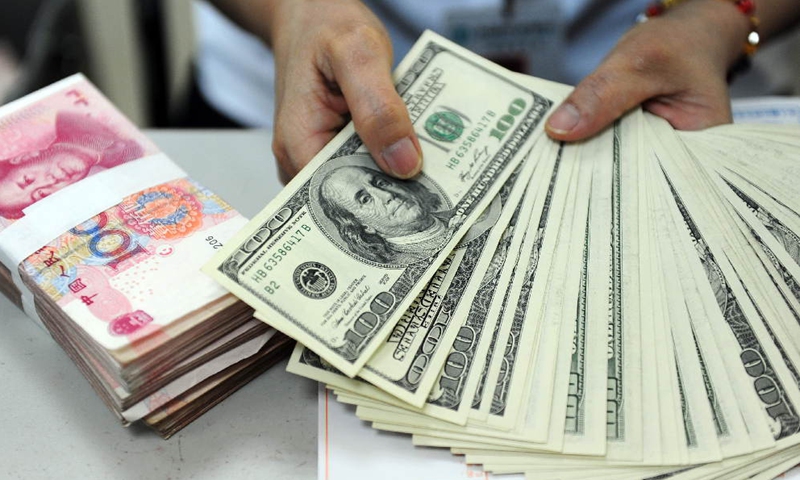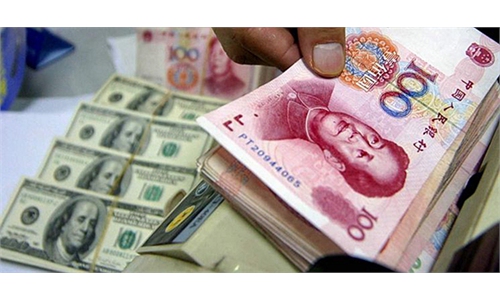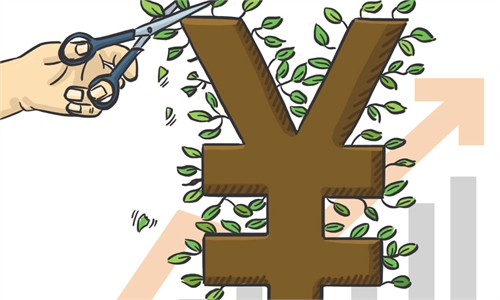
A staff member counts banknotes at a bank in Qionghai of south China's Hainan Province.(Photo: Xinhua)
Following a steep drop in the last month, the Chinese yuan bounced back by nearly 1,000 basis points to 6.6740 on Friday. The expanded two-way fluctuations of the currency further impact China's exports that has already been under pressure due to the COVID-19 resurgences in cities including Shanghai.
However, experts said that there is no basis for either long-term depreciation or appreciation of the yuan, which will return to a reasonable level with the recovery of economic and social activities amid the easing of the pandemic situation.
Between April 20 and May 16, the Chinese yuan fell by 6.2 percent against the US dollar to around 6.80 from 6.38, a steep drop that has been rare in China's foreign exchange market.
Zhang Jiying, an umbrella exporter in Yiwu, East China's Zhejiang Province, told the Global Times on Saturday that overseas buyers that settle in dollars tend to place more orders when the Chinese yuan depreciates.
"However, unlike in the past years, it seems that our foreign clients are not in a rush to receive products this year, with about 20 clients' orders still piled up at our warehouse," Zhang said. She said that her clients are mainly from Russia, Spain, Italy and France, and their businesses have been affected by the pandemic and international uncertainties like the Russia-Ukraine conflict.
An anonymous businessman in the semiconductor sector told the Global Times that some of the company's exports made about a month ago indeed yielded more profit under the existing exchange rate, but that couldn't offset losses of last year, when the currency surged to a three-year high against the dollar.
China strives to maintain the yuan's exchange rate basically stable, as a stronger yuan makes China's goods relatively more expensive and less competitive in the international market, while a weaker yuan may lead to outbound flight of domestic assets.
In the first four months of 2022, China's trade amounted to $1.98 trillion, up 10.1 percent year-on-year. Over the period, the country's exports jumped 12.5 percent year-on-year to $1.09 trillion, while imports increased 7.1 percent to $881.4 billion, data from the General Administration of Customs showed.
Analysts with China International Capital Corp (CICC) said in a note posted on the company's WeChat account that the yuan's exchange rate may strengthen to 6.65 per dollar by the end of second and third quarters, with the yuan's exchange rate showing two-way fluctuations in line with domestic and external changes, however the fluctuation range has sustainably narrowed.
The yuan's exchange rate against the dollar is expected to stay at 6.7 during the first quarter of 2023, as the dollar may strengthen due to the negative impact of the US Federal Reserve's interest rate hikes on other economies, according to CICC analysts. However, the yuan's exchange rate against a basket of currencies will remain stable, as it remains supported by the economy's sound fundamentals.
Recent depreciation of the yuan was a short-term adjustment that will not change the general characteristics of the yuan's exchange rate featuring two-way fluctuations and general stability at a reasonable and balanced level, Wang Chunying, spokesperson and deputy head of the State Administration of Foreign Exchange, told the Xinhua News Agency in a recent interview.
"For a mega economy like China, the long-term trend in the exchange rate is mainly determined by domestic fundamentals," Wang said, noting that despite recent depreciation against the US dollar, the yuan has remained relatively stable against other major currencies.
The share of the Chinese yuan in the IMF's Special Drawing Rights basket has risen from 10.92 percent to 12.28 percent, the People's Bank of China (PBC), the country's central bank announced on Sunday.
The PBC said in its monetary policy report for the first quarter of 2022 that it sticks to a managed floating exchange rate system based on market supply and demand, and adjusted with reference to a basket of currencies. In addition, the central bank will guide expectations to keep the yuan exchange rate basically stable at a reasonable and balanced level.
On Friday, the central bank lowered the five-year loan prime rate (LPR) by 15 basis points to 4.45 percent in May, its biggest cut in the mortgages-referenced benchmark for longer-term lending.


